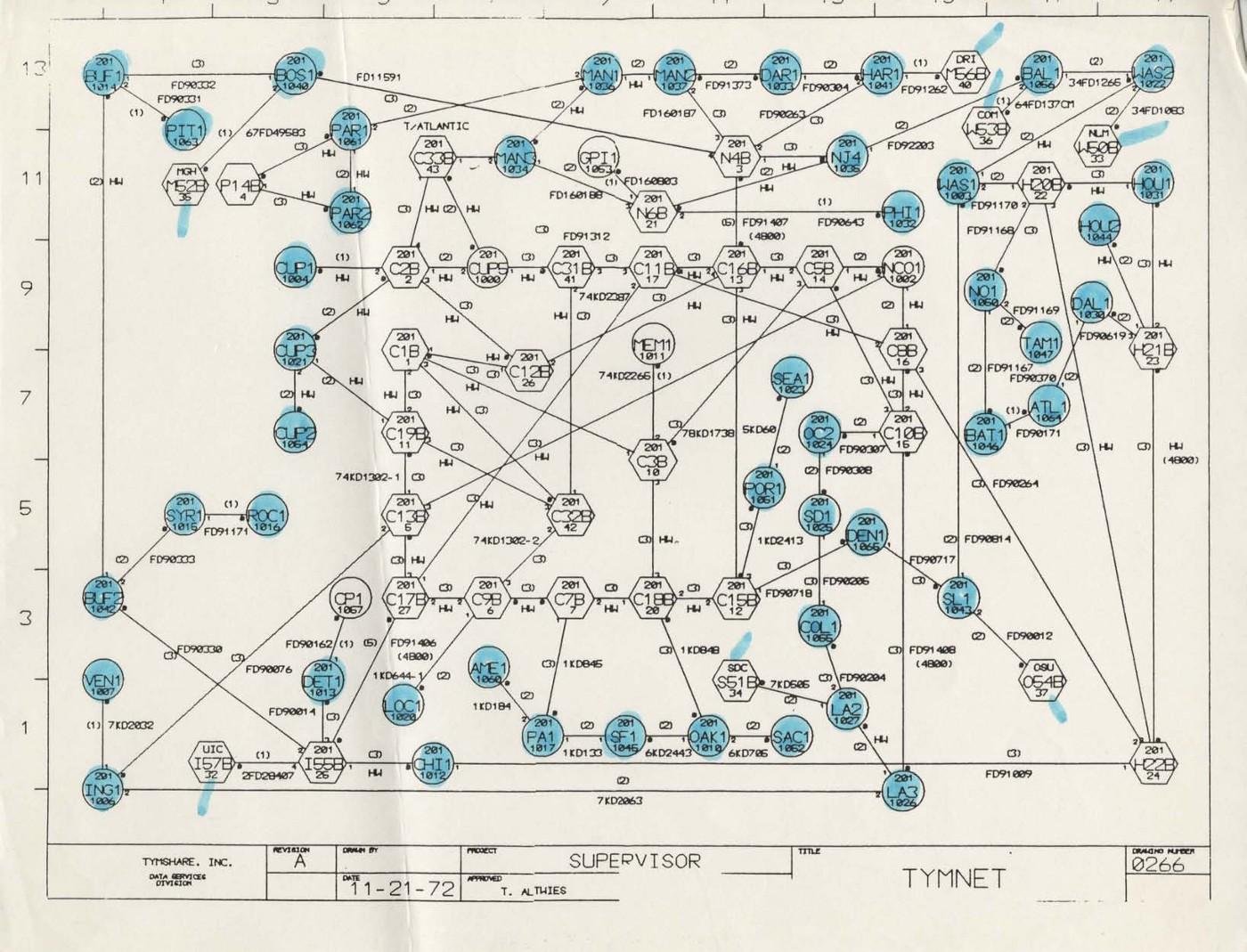Getting Better (not More) Data from Alarm Companies to PSAPs
Every year, PSAPs field millions of requests for assistance from alarm companies. New technology is simplifying the process in ways that promise to...
Those of us from the information technology profession did you a disservice many years ago when we first drew the early concept of the Internet—of shared computing and data—as a simple “cloud.” That one diagram, meant to simplify the representation of complex technology, may have unwittingly spawned years of confusion that persists to this day.
The Origins of the Cloud:
The Tymnet Data-Communications Network

© Tymshare, Inc. [Image courtesy of the Computer History Museum]
CNBC once characterized cloud computing as some sort of coin toss: “Cloud computing may be the most innovative technology development in decades—or regarded as just a mass marketing tool for know-how that's as old as computers themselves.” Over the years, we may be learning that both of those portrayals can be true at the same time. The availability of hyperscale public cloud has been a game-changer in how rapidly we can develop innovative solutions and manage massive amounts of data, while much of the underlying information and communication technologies are well established but just applied in creative ways.
The cloud was invented, in part, as a response to high-cost and scalability constraints during that era of computing, where demand for compute resources and expertise to manage them simply outpaced the supply of both. Much has changed since these early beginnings, while much is still the same. We now have an almost ubiquitous supply of compute resources but the availability of skilled technologists to appropriately apply them has only continue to grow.
Pooling or sharing those resources offered a solution, yes, but what were the technologists of that era really trying to achieve? Innovation. And what did they see as the key to innovation? Data. Bits and bytes of data that were isolated on islands of local computing. Untapped potential for innovation and collaboration.
So, what if we looked at the cloud story as really a data story? For it’s the data—the relevant situational awareness—that you probably care about more than the microprocessors. 911 is a symphony of data: Which PSAP should field this call? What is the location of your emergency? Does the patient have a medical condition? Here’s a procedure to administer CPR. In the voice-over-IP world, even the 911 call itself takes the form of data.
All of the hardware architectures and software applications that we assemble for public safety are designed to collect, process, analyze, retrieve, store and communicate all that data to telecommunicators and administrators in a clear and meaningful way. Data when you need it, data where you need it, data how you want it (and for NG911, how much), and data that you can trust and secure.
Before the era of connected devices and the Internet of Things, the data generated by a 911 call didn’t necessarily require us to use the cloud in a way that many other industries had done years earlier. A bank processing millions of financial transactions daily or a large retailer organizing giant supply chains needed to store, analyze, and share vast amounts of data. Some of the most vital data they stored themselves; much of the data didn’t require the significant cost expenditures for dedicated hardware that was also difficult to maintain. So, they looked to share that computing power across their organization through their own data center (or “private” cloud) or offloaded it to a third party that specialized in such technology (the “public” cloud). Or some combination thereof, in a combination of those approaches (a “hybrid” cloud).
So, public safety isn’t necessarily late to the cloud game; it’s more that it hadn’t been necessary for us to complete our mission--until the Internet of Things and NG911. The vision for NG911, including the capture and sharing of vast amounts of data, required us to rethink our IT architectures and forge a rational, managed evolution to the cloud. A managed evolution is one that establishes a thoughtful series of steps between the current state and a future one while minimizing technology and business risk while maximizing end customer value and stability.
A managed evolution is one that establishes a thoughtful series of steps between the current state and a future one while minimizing technology and business risk while maximizing end customer value and stability.
Why a managed evolution? In the same way that financial institutions use a hybrid cloud, we, too in public safety, can use a ‘fit-for-purpose” configuration of leading information and communication technologies to best serve the public in their time of need. We need to leverage the strengths and compensate for the weaknesses of these technologies based on the requirements of the 911 workflow. We use the public cloud for what it’s good at and the private cloud for what it’s good at. Hence, the hybrid cloud approach.
To appreciate a hybrid cloud approach, it might be helpful to step back a bit and look at some of the cloud terminology that’s thrown about and what it might mean for public safety.
According to Google Cloud, “Hybrid cloud computing approaches are widespread because almost no one today relies entirely on the public cloud." Google points out that a hybrid cloud approach offers greater flexibility and data controls but also allows users to "modernize at your own pace." As we discussed in Migrating to the Cloud, the move to the cloud isn’t as simple as hitting the proverbial “easy button,” at least not for public safety where reliability is Job One.
A hybrid cloud approach may also offer a better chance of fulfilling a cloud-first strategy. The trust concerns over the cloud, real or not, appear to impede the rate of adoption of cloud technologies. According to an IDG survey, “Those who define cloud first as hybrid cloud strategy have made the most progress with IT transformation versus cloud only.”
Cloud-first thinking and hybrid cloud implementation marry well with NG911. It’s ambitious but not reckless. We will learn as we go how to capture, filter, and manage all the data available to use in call handling and dispatch—without overwhelming the telecommunicator. Likewise, we won’t just throw everything we do in the workflow into the cloud. I’ve seen too many YouTube videos where vendors rip out legacy systems and replace them with cloud-native solutions, where everyone in the building stands anxiously with their fingers crossed, hoping the first call will be completed. There is no room for finger-crossing in 911!
So, while a managed evolution to the cloud might sound slow and tedious, the intent is to build in a safety net during the migration. In a recent sit-down I had with Jeff Robertson, the president of Intrado Life & Safety [see Intrado is Bringing Life & Safety to the Clouds], we spoke about the need for every 911 call to go through with five-9's (99.999%) reliability. We have to view cloud technologies with that frame of mind. Every i3-architected request for assistance must be able to find a way to get to a telecommunicator, especially in the worst of times.
That means that we have to look at the cloud in the context of the architecture that we build across the entire 911 continuum. We must factor in the network and nodes that call must traverse from those in need to those who can help. If we want to take advantage of internet access to the cloud, then we must factor in that the architecture of the Internet is built for “best-effort” communications (no guarantees that the data will be delivered), not five-9s. And while public cloud providers continue to innovate their security and reliability, those solutions are today best geared for non-critical workloads like call recording or mapping storage and retrieval.
A managed evolution then is a rational evolution: taking advantage of innovation and avoiding unacceptable risks by adapting technology, not just adopting it. These remarkable information technologies were not built for any one singular industry segment, let alone the unique life-saving, high consequence characteristics of 911; many were created to serve the broadest possible use cases. So, we need to envision the flow of data for NG911 and build our computing architectures around that view, both for today and for years to come. We see the cloud not just as a shiny technology but as a means to an end…helping you serve the public.

Every year, PSAPs field millions of requests for assistance from alarm companies. New technology is simplifying the process in ways that promise to...

Intrado Revolution is an emergency mass notification system that unifies disparate technology into a centralized platform. This software connects...

Regardless of whatever new technology is introduced into the 911 space—cloud-based, artificial intelligence, the ESInet—it is all informed by data....

Intrado’s managed evolution to the cloud means that our network is extraordinarily resilient and flexible, whether you’re a big city PSAP or a...